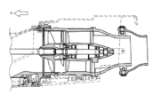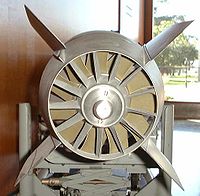
Pump-jet
Encyclopedia


Ocean
An ocean is a major body of saline water, and a principal component of the hydrosphere. Approximately 71% of the Earth's surface is covered by ocean, a continuous body of water that is customarily divided into several principal oceans and smaller seas.More than half of this area is over 3,000...
system that creates a jet of water
Water
Water is a chemical substance with the chemical formula H2O. A water molecule contains one oxygen and two hydrogen atoms connected by covalent bonds. Water is a liquid at ambient conditions, but it often co-exists on Earth with its solid state, ice, and gaseous state . Water also exists in a...
for propulsion
Marine propulsion
Marine propulsion is the mechanism or system used to generate thrust to move a ship or boat across water. While paddles and sails are still used on some smaller boats, most modern ships are propelled by mechanical systems consisting a motor or engine turning a propeller, or less frequently, in jet...
. The mechanical arrangement may be a ducted propeller
Ducted propeller
A ducted propeller is a propeller fitted with a non-rotating nozzle. It is used to improve the efficiency of the propeller and are especially used on heavily loaded propellers or propellers with limited diameter. It was developed by Luigi Stipa and Ludwig Kort .Advantages are increased efficiency,...
with nozzle
Nozzle
A nozzle is a device designed to control the direction or characteristics of a fluid flow as it exits an enclosed chamber or pipe via an orifice....
, or a centrifugal pump
Centrifugal pump
A centrifugal pump is a rotodynamic pump that uses a rotating impeller to create flow by the addition of energy to a fluid. Centrifugal pumps are commonly used to move liquids through piping...
and nozzle. The first functioning man-made pump-jet engine was created by New Zealand
New Zealand
New Zealand is an island country in the south-western Pacific Ocean comprising two main landmasses and numerous smaller islands. The country is situated some east of Australia across the Tasman Sea, and roughly south of the Pacific island nations of New Caledonia, Fiji, and Tonga...
inventor Sir William Hamilton
Bill Hamilton (engineer)
Sir Charles William Feilden Hamilton , commonly known as Bill Hamilton, was a New Zealander who developed the modern jetboat, and founder of what is now the world's leading water jet manufacturing company - CWF Hamilton Ltd .Hamilton never claimed to have invented the jet boat. He once said "I do...
in 1954.
Advantages
Pump jets have some advantages over bare propellers for certain applications, usually relate to requirements for high-speed or shallow-draftDraft (hull)
The draft of a ship's hull is the vertical distance between the waterline and the bottom of the hull , with the thickness of the hull included; in the case of not being included the draft outline would be obtained...
operations. These include:
- Higher speed before the onset of cavitationCavitationCavitation is the formation and then immediate implosion of cavities in a liquidi.e. small liquid-free zones that are the consequence of forces acting upon the liquid...
, because of the raised internal dynamic pressure - High power density (with respect to volume) of both the propulsor and the prime mover (because a smaller, higher-speed unit can be used)
- Protection of the rotating element, making operation safer around swimmers and aquatic life
- Improved shallow-water operations, because only the inlet needs to be submerged
- Increased maneuverability, by adding a steerable nozzle to create vectored thrust
- Noise reduction, resulting in a low sonarSonarSonar is a technique that uses sound propagation to navigate, communicate with or detect other vessels...
signature; this particular system has little in common with other pump-jet propulsors and is also known as "shrouded propeller configuration"; applications:- submarineSubmarineA submarine is a watercraft capable of independent operation below the surface of the water. It differs from a submersible, which has more limited underwater capability...
s, for example the Royal NavyRoyal NavyThe Royal Navy is the naval warfare service branch of the British Armed Forces. Founded in the 16th century, it is the oldest service branch and is known as the Senior Service...
Trafalgar-classTrafalgar class submarineThe Trafalgar class is a class of nuclear-powered fleet submarines in service with the Royal Navy. They are a direct follow on from the Swiftsure class and were, until the introduction of the Astute class, the Royal Navy's most advanced nuclear fleet submarines.Seven boats were built and...
and Astute-classAstute class submarineThe Astute-class is the latest class of nuclear-powered fleet submarines in service with the Royal Navy. The class sets a new standard for the Royal Navy in terms of weapons load, communication facilities and stealth. The boats are being constructed by BAE Systems Submarine Solutions at...
, the US NavyUnited States NavyThe United States Navy is the naval warfare service branch of the United States Armed Forces and one of the seven uniformed services of the United States. The U.S. Navy is the largest in the world; its battle fleet tonnage is greater than that of the next 13 largest navies combined. The U.S...
Seawolf-classSeawolf class submarineThe Seawolf class is a class of nuclear-powered fast attack submarines in service with the United States Navy. The class was the intended successor to the , ordered at the end of the Cold War in 1989. At one time, an intended fleet of 29 submarines was to be built over a ten-year period, later...
, the French NavyFrench NavyThe French Navy, officially the Marine nationale and often called La Royale is the maritime arm of the French military. It includes a full range of fighting vessels, from patrol boats to a nuclear powered aircraft carrier and 10 nuclear-powered submarines, four of which are capable of launching...
Triomphant class, and the Russian Navy Borei classBorei class submarineThe Borei class is a class of nuclear-powered ballistic missile submarine produced and operated by the Russian Navy. The class is intended to replace the Delta III, Delta IV and Typhoon classes now in Russian Navy service...
. - modern torpedoes, such as the SpearfishSpearfish torpedoThe Spearfish torpedo is the heavy torpedo used by the submarines of the Royal Navy. It can be guided by wire or by autonomous active or passive sonar, and provides both anti-submarine warfare and anti-surface ship warfare capability.It replaces the unreliable Tigerfish torpedo, which was...
, the Mk 48Mark 48 torpedoThe Mark 48 and its improved ADCAP variant are heavyweight submarine-launched torpedoes. They were designed to sink fast, deep-diving nuclear-powered submarines and high-performance surface ships.-History:...
and Mk 50Mark 50 torpedoThe Mark 50 torpedo is a U.S. Navy advanced lightweight torpedo for use against fast, deep-diving submarines. The Mk-50 can be launched from all anti-submarine aircraft and from torpedo tubes aboard surface combatant ships. The Mk-50 was intended to replace the Mk-46 as the fleet's lightweight...
weapons.
- submarine
The principles of air thrust vectoring have been adapted to advanced sea applications in the form of fast water-jet steering [pump jets] that provide sea super-agility. Examples are the fast patrol boat Dvora Mk-III craft, the HAMINA Stealth Attack craft and the new U.S. Littoral Combat Ships [LCS][3].
Disadvantages
- Can be less efficient than a propeller at low speed
- More expensive
- Higher weight in the boat because of entrained water
- Will not perform well if the boat is heavier than the jet is sized to propel
- Can suffer more easily from cavitationCavitationCavitation is the formation and then immediate implosion of cavities in a liquidi.e. small liquid-free zones that are the consequence of forces acting upon the liquid...
than a conventional propeller - Can become clogged with debris; e.g., seaweed
See also
- PropulsorPropulsorA propulsor is a mechanical device that gives propulsion. The word is commonly used in the marine vernacular, and implies a mechanical assembly that is more complicated than a propeller. The Kort nozzle and Pump-jet are examples....
- Personal water craftPersonal water craftA personal water craft , also called water scooter, is a recreational watercraft that the rider rides or stands on, rather than inside of, as in a boat....
- Jet skiJet skiJet Ski is the brand name of a personal watercraft manufactured by Kawasaki Heavy Industries. The name is sometimes mistakenly used by those unfamiliar with the personal watercraft industry to refer to any type of personal watercraft; however, the name is a valid trademark registered with the...
- JetboatJetboatA jetboat is a boat propelled by a jet of water ejected from the back of the craft. Unlike a powerboat or motorboat that uses a propeller in the water below or behind the boat, a jetboat draws the water from under the boat into a pump inside the boat, then expels it through a nozzle at the...
- WetbikeWetbikeA WetBike is a planing water motor cycle that is often described as cross between a motorcycle and a jet ski.The original Wetbike was introduced in 1978 by Spirit Marine, a subsidiary of Arctic Enterprises . The Wetbike is challenging to ride, because it does require a good deal of balance...
- Kitchen rudderKitchen rudderThe Kitchen Rudder is the familiar name for "Kitchen's Patent Reversing Rudders", a combination rudder and directional propulsion delivery system for relatively slow speed displacement boats which was invented in the early 20th century by John G.A.Kitchen of Lancashire, England...
- Water rocketWater rocketA water rocket is a type of model rocket using water as its reaction mass. The pressure vessel—the engine of the rocket—is usually a used plastic soft drink bottle. The water is forced out by a pressurized gas, typically compressed air...
Sources
- Charles Dawson, "The Early History of the Water-jet Engine", "Industrial Heritage", Vol. 30, No 3, 2004, page 36.

